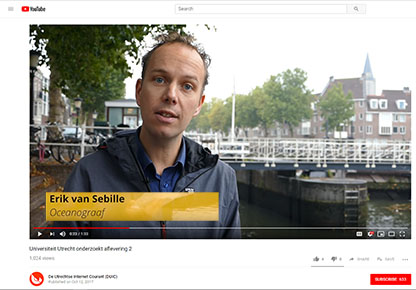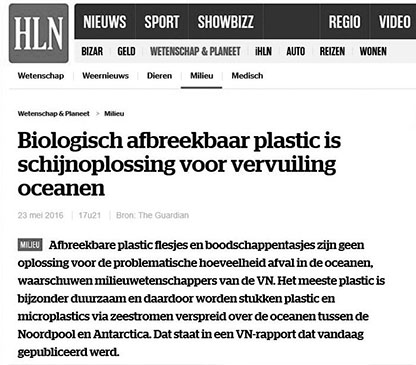Types of plastic
Plastics have many different characteristics. Some are rigid, while others are flexible. They can be transparent or brightly coloured. These different characteristics mean that plastic can have many different chemical compositions.
Eternal plastic
There are different types of plastic: bioplastic, biodegradable plastic, and ordinary plastic. All of that ‘ordinary plastic’ is made from fossil fuels, such as natural gas, oil, or coal 1. Bioplastic is different in that it’s not made from oil or gas, but from renewable resources. As a result, it can break down entirely into CO2 and water.
Scientist Erik van Sebille explains the dangers presented by microplastic in the ocean problemen when the plastics make it to the ocean. In this video scientist Erik van Sebille explains what those problems are.
From bioplastic to microplastic?
Bioplastic is made without using fossil resources, which means that it can break down into its component chemicals water, carbon dioxide, and methane. That may seem like the ideal solution, but much of the bioplastic doesn’t get broken down, it simply breaks into smaller pieces called microplastic 6. Also, when bioplastic breaks down it can release toxic substances that can be hazardous to the health of animals and humans.
Biodegradable, but not in the ocean!
You’ve probably heard of biodegradable plastic. It may seem to be a solution to the whole plastic problem, because if plastic can decay in nature, it can’t get blown or washed into the ocean. Unfortunately, that’s not how it works. Biodegradable plastic can often only be broken down through exposure to large amounts of light, oxygen, and heat 3. These conditions are anything but ‘natural’, especially in the oceans. That means even biodegradable plastic can remain in the ocean for a very long time 4 5.
[well size=”sm”]
ALL types of plastic last a long time
Plastic is a durable product, and most plastics are not biodegradable 2. Dit betekent dat al het plastic dat vandaag wordt gemaakt nog voor tientallen, zo niet honderden jaren blijft bestaan. That means all of the plastic produced today will be around for decades, if not for centuries. Since plastic has only been mass-produced for the past 70 years or so, it’s impossible to know how long it will remain in the ocean. Some plastics are easier to break down than others, and we call those ‘biodegradable plastic’, but as the HLN article (in Dutch) explains, biodegradable plastic is not a solution for the plastic soup.
[/well]
[collapsibles]
[collapse title=”Sources”]
1 Plastics Europe (2017) Plastic the facts. – Website
2 Andrady, A. L. (1994). Assessment of environmental biodegradation of synthetic polymers. Journal of Macromolecular Science, Part C: Polymer Reviews, 34(1), 25-76.
3 Swift, G. (2002). Degradable polymers and plastics in landfill sites. Encyclopedia of Polymer Science and Technology, 1-13.
4 Kyrikou, I., & Briassoulis, D. (2007). Biodegradation of agricultural plasticfilms: a critical review. Journal of Polymers and the Environment, 15(2), 125-150.
5 UNEP (2015) Statement of UN leadership on the occasion of World Environemtn Da2015: ”Seven billion dreams. One planet. Consume with care” – Website
6 Hopewell, J., Dvorak, R., & Kosior, E. (2009). Plastics recycling: challenges and opportunities. Philosophical Transactions of the Royal Society of London B:Biological Sciences, 364(1526), 2115-2126.
7 Rochman, C. M., Tahir, A., Williams, S. L., Baxa, D. V., Lam, R., Miller, J.T.,& Teh, S. J. (2015). Anthropogenic debris in seafood: Plastic debris and fibers from textiles in fish and bivalves sold for human consumption.
Scientific reports, 5, 14340.
[/collapse]
[collapsibles]
More interesting info..







